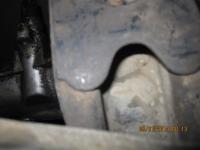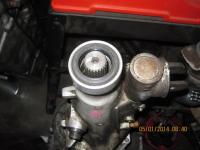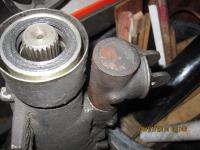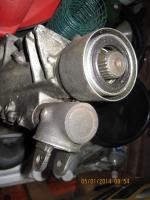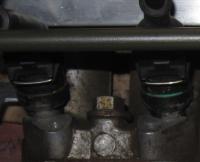Everything posted by Zed Head
-
Modern injectors, new fuel rail - no heat soak problem
The time from shutoff to restart really needs to be noted. 5-10 minutes: generally OK, 30 minutes on: generally OK, 10 - 30 minutes: most likely time to have restart issues. Congrats on getting the car running well. I did have ~3 seconds of what felt like the old problem today after a long drive, in hot weather (high 80's), with about a 20 minute stop before restarting. It cleared up right away, but gives the impression that the problem can still be induced, but the threshold is much higher, which should make the problem time window much narrower. On the heat pipe principle: I wonder if someone could build a "worm" (saw the word on a moonshiner shows on the Discovery channel) or distillation coil between the rail and the FPR or the inlet to remove heat. Just seems like a lot of heat to remove through six small injector bodies. Here are few links about heat pipes. I learned the technology from Kona Corp. before they got bought. The second link has a good picture. In our case, no wicking, just gravity. http://www.synventive.com/aboutus/default.aspx?id=44342 Endless-sphere.com ? View topic - Definitive Tests on the Heating and Cooling of Hub Motors I might start an aluminum fuel rail survey over on Hybridz.org to see if there's a trend. pallnet has sold a few barbed rails so they are out there.
-
Gearbox ID
Wow, that's a good catch on the missing bump. I managed to get a picture of my oily 1980 transmission, by sticking a camera under there and taking a bunch of shots. It has the bump. So does my 83, but the 78 stops sharply at the mid-point parting line. You know though, if you look closely, you can see the bump on Werup's picture. It has a slope to it which doesn't really show in Eurodat's picture, which looks almost perpendicular, maybe due to camera angle. The slope is easily visible on my 83 sitting in the garage, and visible in my oily picture. One other thing I notice, which doesn't seem to get mentioned, is that the early transmissions have a double dust shield at the drive shaft yoke. The one on the drive shaft slips in between the aluminum housing and a separate shield on the transmission, with the transmission shield ending up on the outside. On the later transmissions, the driveshaft shield ends up on the outside, they got rid of the shield on the transmission. Edit - went a little crazy and retook some pictures, showing the dust shield and the shifter ears. You can see the short ears on the 4 speed, but long on 78 and 83 5 speeds. I almost went overboard and cleaned the garage for better pictures, but managed to stop myself.
-
Help Please! Ground Control Install - Strut inserts too long?
I think that what you took out are the original damper assemblies. They are essentially the internals of a shock absorber and the strut housing is the outer tube of the shock. I did the same on my 76. The KYB's should have come with their own nut, it's called a gland nut and it's designed to fit the top of the shock. It's also possible that there is some crud down in the bottom of the tube. I think I may also have read about the occasional weld bump down there also, that needs to be dealt with. The KYB's with the KYB gland nuts should work. You don't want to use the old gland nuts with the new KYB's. But with the KYB's you'll be at the same ride height, plus a little extra from the gas charge. Find the KYB gland nuts and try again. That's all there is, the gland nut, the insert, and the strut tube.
-
Modern injectors, new fuel rail - no heat soak problem
I've pondered the heat pipe heat removal process. I figured that it was happening but apparently not removing enough heat. It's a viable explanation though. Maybe Nissan knew that and that's why they describe their cooling fan's purpose as to remove heat from the fuel system, and that's why it blows on the rail. Could also be why several of the manufacturers use some pretty fancy aluminum rails, and some of them are even finned (one side benefit of prowling the wrecking yards is you see a lot of stuff you would never see otherwise). Which I had though would draw heat in from the engine bay, but it's all about differential so engine off maybe fins are good, to dissipate heat to the engine bay surroundings. It works for me, taking heat from the injector body, and fits the two cases so far. Mine and siteunseens. pallnet, the Hybtridz link I referenced above, sells rails with barbs. It could be that simple (Occam and Einstein and all those guys, you know). On the clips - the factory clips usually fit around a round projection (the manufacturers typically use a stamped pipe type hole for the injector). You'd have to design your own but I'm sure it could be figured out.
-
Help Please! Ground Control Install - Strut inserts too long?
What was in there before? Does it have part numbers? To CO's point - some shocks come with a pressed on extension. It might still be in there.
-
Help Please! Ground Control Install - Strut inserts too long?
Yes, you need a shorter shock to run in a sectioned tube. You'll have to search around to find the right numbers, I think that some people run the fronts in the back, then use an MR2 shock for the front. There are probably some good writeups on Hybridz.org. Good luck. By the way, measuring first with the shock in hand is the way to go. As you've found.
-
Help Please! Ground Control Install - Strut inserts too long?
Isn't that the other side of the strut mount, where the ball joint bolts on? Looks normal, I believe. It's the inside of the tube that matters. You might have four rear shocks. The fronts are shorter, by about 3 1/8", for a 280Z. If my measurements on some Tokicos are correct. ~18" for the rears, and 14 7/8" for the fronts.
-
Gearbox ID
The gear shift levers will swap across all 71B transmissions. Even though MSA, for example, sells short shift kits for different year cars. And the ears-on-the-shift-mechanism things is wrong I believe. I have a 76 4 speed, and and a 78 and 83 5 speed in the garage and an 80 in the car. The length of the ears doesn't tell anything. If you want to get closer to knowing what you have, measure the ratio of 5th gear by marking the driveshaft and turning the engine until the driveshaft turns one revolution. Then see how far the crankshaft rotated. The exhaust hanger and the speedo bolt put you in the 80-83 range. I think that the main difference in parts is the 5th gear synchro ring though. If you're not buying a 5th gear synchro ring, parts for the 80-83 5 speed should work. Eurodat knows more and might have some comment. 1980 - .773 1981-83 - .745
-
Modern injectors, new fuel rail - no heat soak problem
The heat pipe theory is a good one. It should work for the standard fuel rail also though, but without the surface area and conductivity of the aluminum rail. Vapors are free to rise in the stock system also, up through the rubber hose to the metal rail. Maybe the aluminum rail is enough to keep the injector bodies below the threshold. Could be why siteunseen's rubber hose/aluminum rail system works. Or, as you suggest, there's just more fuel available to keep the cooling cycle going. If siteunseen didn't have headers, he would have the fuel rail as the single variable experiment. Except for the 707T injectors. There has to be more people out there with the barbed fuel rails, running stock injectors. Maybe another survey is in order. The problem with the problem is that the people who don't have it, don't really know what we're talking about. Little reason to get involved. Maybe the accumulator theory is right, and the accumulator is a just a cooling fluid reservoir. Eventually the minimum work necessary or a set of factors that can control it will be clear, I hope. I think that the o-ring system is only more dangerous because the safety built in to it by the designers has been removed. In a factory stock system, each injector has a clip holding the injector in to the rail. You can pressurize the rial without it being bolted down. If it comes unbolted, no fuel escapes. If pressure is applied to these aftermarket rails, unbolted, the injectors will just pop out.
-
Cam sprocket on #3
Yes. I guess I didn't differentiate between distributor and crankshaft. I get 22 degrees of timing advance beyond the 12 degrees static/initial by the timing light, after ~2500 RPM (a guess from the FSM specs). I have a 78 distributor, but it has 11 degree distributor weights (the FSM says it should have 8.5), or 22 degrees at the crankshaft. Sorry, probably not helping the thinking overload.
-
Cam sprocket on #3
As madkaw says, two different timing scenarios, one cam, one ignition. On the ignition. if you want to get precise or match what you had before, compare the total mechanical advance of the distributors. There should be a number stamped on the weights under the breaker plate. Twice that number is total mechanical advance of the distributor. If you don't want to take the ZX unit apart, you can set the timing to zero at idle, disconnect the vacuum advance, and measure timing while increasing RPM until the mark stops moving. That would be total for the ZX distributor. I have 22 degrees total in my distributor, and I'm set at 12 initial, for 34 total at WOT, for example.
-
Water getting inside car through doors when washing my 240z! What seals i need?
The part number is in Post #6 in the thread I linked in Post #4 above. Do you have Kia dealers down there? They're actually longer than needed. Typically, you fit the 90 degree bend of the weather-strip to the 90 degree bend on the car, then run the rest of the stripping and trim the ends. Edit re jfa below - the range of years are in that other thread also.
-
Modern injectors, new fuel rail - no heat soak problem
Quoting myself. I found an old thread about the 707T's - http://www.classiczcars.com/forums/fuel-injection-s30/45474-fuel-injectors-fj3-fj707t.html
-
Modern injectors, new fuel rail - no heat soak problem
Yes, these have the 14mm o-ring seal and the top of the injector is about 6 mm (a guess) from the stream of fuel flowing past. No long rubber hose. That's an interesting question about what holds the injectors in place. The aftermarket aluminum fuel rails that everyone is using typically rely on the injector rail itself as a long rigid clamp on the tops of the injectors. As I was working on mine I was thinking about dangerous the whole setup is, with six large holes just waiting to spew fuel on a hot engine if the mounting brackets come loose. To your point - I didn't use the mounting seats but may reinstall them in the future. I spent extra time making sure my rail was secure. So the injector is exposed completely, just sitting in the intake manifold hole. Who knows, it could be a factor in heat transfer. If I use the mounts again I'll have to make sure the seal to the manifold gets enough compression. I'll take a picture and post it later. Here's a closeup of 5 and 6. The overall setup is very industrial. My hood generally stays closed. That's the fuel return line in front of the injector clips.
-
Modern injectors, new fuel rail - no heat soak problem
Thanks, I'm glad too, very glad. I didn't know the Standard brand had a different injector outlet. My BWD's apparently came from the same location, in South Carolina (another guess based on maps from their web sites), but have the typical single hole with a pin sticking out. Also, the end is covered with a plastic pintle cap. I wonder if Standard didn't incorporate new technology to produce to an old spec. with the FJ707T. What would be weird though, if the T is better than regular FJ707 for heat soak, is that the T series is the low budget line, according to Standard's description (no offense, I have some T series ignition modules myself, waiting as spares). That would be something if that was the case. Cure for heat-soak = low budget eBay 707T injectors.
-
how to wire a pertronix up when you have a 3 kohm coil on a 71 240Z.
I don't think that Pertronix even considers the Z cars as a market anymore. You have to search for an Ignitor by distributor number and none of the numbers I've seen listed for 240Z's show up. I checked the two FSM's that are available on the web. Also, if you open any of the instructions for the Ignitor I kits you'll see that one of the first statements shown is about leaving the key on. The Ignitor II is more like the stock 280Z module or a GM HEI module in that it has circuitry to prevent overheating, probably some sort of timer that cuts current if there's no action within a certain time. I'm guessing from previous reading. Plus they took out the warning about leaving the key on. The II also has "dwell" (current) control like the GM HEI and the stock 280Z modules. Plus you don't have to worry about resistors or ballast, just get a low resistance coil. If I was going to use an Ignitor, I would find a II that works. How you find one though, is the dilemma, if it exists. The Ignitor I is old technology but I guess place like MSA will keep selling as long as people keep buying. JEGS seems to think that this Ignitor II fits a Z distributor although the Pertronix site doesn't. It's a problem. Pertronix 91761 Pertronix Ignitor II Kits - Free Shipping on All Orders @ JEGS Ignition Products
-
Modern injectors, new fuel rail - no heat soak problem
I might as well post this up. I just got back from a long drive, with several stops, and not a sign of the heat soak problem. I've made several changes but I think this would be easy for anyone to do, with an adjustable fuel pressure regulator as backup for any tuning, rich or lean, that needs to be done. Since it's only me for now though, the risk is there that I just got lucky. Hopefully it's real, I don't want to cause anyone to waste time or money. I’ve been running more modern injectors (1989) for five days now, and they seem to be immune to the heat soak problem. Or the overall modified fuel system is. I’m using 14 mm injectors, Bosch 280 150 901, with the injector o-ring as a seal to the intake manifold, bypassed resistors (just link all of the wires from the harness together on each plug) since they’re high impedance, a straight through aluminum fuel rail (the typical type), and no injector mounts (the rail holds the injectors down and the fuel pressure presses the o-ring against the manifold for the vacuum seal). I have an adjustable FPR but it is set to 36.5 psi. I also have the potentiometer on the coolant temperature circuit but it is set to zero. Previously, with my old original 1978 injectors, I had a very small amount of added resistance. So these may run a hair rich. Maybe they run the way the ECU expects them to run. I tested them three times right after installing with a drive then a 15 minute wait and restart, another drive and 15 minutes, then a long drive and a 40 minute wait, and since then just normal daily driving. They haven’t missed a beat, not even a hint of the typical heat soak signs. I didn’t put my cooling fan hose back on just to make sure I wouldn’t turn it on by accident and screw up results. I’ve copied below the links I used to choose the injectors and a few more to show the typical rail installation. Of course, with so many changes it’s hard to say exactly what made the difference. Here’s a link to flow rates and other variables. There is a variety to choose from with ~188cc/min. I bought one injector from the wrecking yard and compared the flow rate to stock BWD replacement injectors that I already had mounted up on my testing device (a stock rail, six injectors wired in series, a fuel pump, filter, and some switches). Just ran them wide open for a certain time in to a Coke bottle and eyeballed final levels. They were identical. Crude, but so is the EFI system. Note that the flow rates don’t work out if you use the typical flow rate versus pressure calculator. But they did in the head-to-head test. I had planned to drop fuel pressure if necessary, but haven’t had to do that. Stan Weiss' - Electronic Fuel Injector (EFI) Flow Data Table Here’s a selection of Bosch injectors, with pictures, that I used to find one that would fit physically. I chose the 901’s for the nozzle and o-ring configuration. I got a set at the wrecking yard, with about 150k miles on them (it’s an experiment!). Bosch Fuel Injector Catalog Wholesale Prices No Charge Specific – Remanufactured Bosch Fuel Injector 0280150901 25531465 Here’s a link to the type of rail I am using. I made my own but it’s generally the same, except for the mounting fixtures. If I had less free time I probably would have just bought one of his. But it was fun to build something new. PALLNET FUEL RAILS - Vendor's Forum - HybridZ The system might be bolt-on no-tuning required, or it might require a minor fuel pressure adjustment. I have not seen any changes in driveablity, they might actually be smoother than the old setup. The idle definitely feels smoother, maybe due to better atomization. The engine still runs great, in general. It might be that something simple like just a straight-shot aluminum rail will do the trick (superlen might have been on the right track with his thoughts on the fuel flow getting side-tracked to one side of the stock rail). siteunseen is using a straight rail with stock injectors and hose clamps and does not have the problem. But he also has headers. My cooling fan experience led me to the injector bodies though, and the fuel rail was necessary to get them installed. I had considered making six adapters to attach hoses on to the 14mm injectors so that they could be used on the stock rail, but couldn't find the materials at the time. I do have materials located now though and may make some up just for a future experiment. That would be the one variable experiment. Anyway, that’s the story. The car behaves like a normal car now. Not even a burp or bobble on hot restart. I’ll come back after these next few hot days (supposed to hit 80), or at the first sign of heat soak problems. If you're reading this and tempted. you should probably wait before buying anything. I've been wrong before. You can always put a plan together though. Edit - the site software or my browser seems to be highlighting phrases like "Bosch injector" to lead people to eBay. Those aren't my links. Don't know how to get rid of it either.
-
Hot-start issue with EFI - who has it, who doesn't
I thought that I would post the link mainly as food for thought. Single pintle versus four hole. I don't even know that the description in the drawing is right, since it talks about a plate but the diagram shows a tapered seat valve. I'm going to start another thread with the details of what I did. My experience with cooling the injector bodies makes me think the problem is in the injectors but I don't have the definitive experiment done, with other variables controlled.
-
Hot-start issue with EFI - who has it, who doesn't
Here's an interesting post I found while Googling around (this is not a reply or reference at all to the last 7 posts here), ignition upgrade and timing bump (no 56K) - Page 106 - FSB Forums Post #2108 (longest thread ever), bottom image with the diagram, talks about deposits on the single pintle design. Could help explain a pintle binding theory. Regardless, it's interesting reading, to me anyway. I've been driving around with new injectors for the last 5 days, but am waiting for the next couple of days here in the Portland metro area to give them a true test, it's supposed to hit 80. But I've also changed to a straight-shot fuel rail so results won't be assignable to a single cause. But all of the changes combined seem to be working.
-
Important OT warning -- Internet Explorer
I'm from the Portland Oregon area and OT just means overtime to me (see Blazers - Rockets). What does it mean here? Kind of kidding, but really don't know. I did see articles about that. Microsoft drops another ball. I found IE to be slow and bloated years ago anyway and it's never improved. Chrome is fast. Firefox used to be the best, but their recent upgrades have become slow also.
-
Water getting inside car through doors when washing my 240z! What seals i need?
The seals from a late 90's Kia Sportage work well. Also, don't forget the shark-fin shaped piece on top of the door front. It's important. http://www.classiczcars.com/forums/body-paint-s30/37308-kia-sportage-weatherstip-rocks.html
-
Transmission ID/quiz
The link below has the FSM's which show model numbers in the MT chapter. Nissan started using the FS5R90A in 1983. Follow the Nissan link to the 300ZX and the Datsun link to the 280ZX. You might start a new thread for your project. It's hard to follow what you're doing with posting in several different ones. How To Use NICOclub.com?s Factory Service Manual Database
-
Ignition troubles :)
Idle speed increasing when you advance the timing is normal, as long as it's already in the right range. Without a light though, you're heading down the path of interacting variables. You might be making changes to fix things that aren't really broken, just out of adjustment, leading to more things out if adjustment and a slow spiral to agony. The most common scenario for the Z EFI systems seems to start with adjusting the AFM. I'm kidding, but most have gone through the process and, after the typical ordeal, they gain a new appreciation for gauges and meters, and start collecting those instead of car parts.
-
Brake Line Size from MC outlets
Many of the parts stores carry pre-flared and fitted brake and fuel lines of various lengths. One way to get the length is to take a piece of wire and bend it around the curves of the piece you're replacing, then straighten it out and measure it. OReilly auto also loans out a variety of tools, I'm pretty sure that a flaring tool is one. Give deposit, use the tool, return it and get the full deposit back. But they also sell pre-fitted lines.
-
Fuel Rail Question/cant get it started
Sounding like a bad ignition module, possibly. You could do the electrical checks in the FSM. Some times the modules are bad enough that the tests will show it. el chapter, page EL-28. The testing procedures are so old though that the module test requires looking for needle waver on a voltmeter. Still worth going through, you could have a bad pickup coil, bad grounds, etc. http://www.nicoclub.com/FSM/280z/1982/1982%20280zx%20FSM/el.pdf




